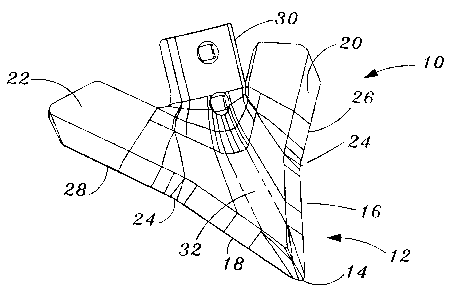Some of the information on this Web page has been provided by external sources. The Government of Canada is not responsible for the accuracy, reliability or currency of the information supplied by external sources. Users wishing to rely upon this information should consult directly with the source of the information. Content provided by external sources is not subject to official languages, privacy and accessibility requirements.
Any discrepancies in the text and image of the Claims and Abstract are due to differing posting times. Text of the Claims and Abstract are posted:
| (12) Patent: | (11) CA 2437941 |
|---|---|
| (54) English Title: | TILLAGE SWEEP |
| (54) French Title: | SOC BINEUR POUR LE TRAVAIL DU SOL |
| Status: | Term Expired - Post Grant Beyond Limit |
| (51) International Patent Classification (IPC): |
|
|---|---|
| (72) Inventors : |
|
| (73) Owners : |
|
| (71) Applicants : |
|
| (74) Agent: | BORDEN LADNER GERVAIS LLP |
| (74) Associate agent: | |
| (45) Issued: | 2007-02-13 |
| (22) Filed Date: | 2003-08-20 |
| (41) Open to Public Inspection: | 2004-03-13 |
| Examination requested: | 2003-08-20 |
| Availability of licence: | N/A |
| Dedicated to the Public: | N/A |
| (25) Language of filing: | English |
| Patent Cooperation Treaty (PCT): | No |
|---|
| (30) Application Priority Data: | ||||||
|---|---|---|---|---|---|---|
|
A tillage sweep includes an elongated nose portion having forward cutting edges which are straight and diverge at an angle of approximately 45 degrees from a leading point. The top of the nose viewed from the side is straight and angles upwardly at an angle of approximately eleven degrees from the planar bottom surface to a juncture with a stem or connecting portion which forms an angle of about 46 degrees with the plane of the bottom surface. The sweep includes outer wing portions with leading cutting edges which are straight and which diverge at an angle of approximately 67 degrees thereby forming an angle of about 11 degrees with the respective forward cutting edges. The overall length of the sweep is greater than the width.
Un soc bineur comporte une partie allongée en forme de nez dont les arêtes tranchantes antérieures sont droites et divergent selon un angle d'environ 45 degrés à partir du point frontal. Le dessus du nez vu de côté est droit et s'incline vers le haut selon un angle d'environ onze degrés à partir de la surface inférieure planaire jusqu'à une jonction avec une tige ou une partie de raccord formant un angle d'environ 46 degrés avec le plan de la surface inférieure. Le soc comporte des parties d'ailes externes munies d'arêtes d'attaque tranchantes droites qui divergent selon un angle approximatif de 67 degrés, formant ainsi un angle d'environ onze degrés avec leur arête tranchante antérieure respective. La longueur totale du soc est supérieure à sa largeur.
Note: Claims are shown in the official language in which they were submitted.
Note: Descriptions are shown in the official language in which they were submitted.

2024-08-01:As part of the Next Generation Patents (NGP) transition, the Canadian Patents Database (CPD) now contains a more detailed Event History, which replicates the Event Log of our new back-office solution.
Please note that "Inactive:" events refers to events no longer in use in our new back-office solution.
For a clearer understanding of the status of the application/patent presented on this page, the site Disclaimer , as well as the definitions for Patent , Event History , Maintenance Fee and Payment History should be consulted.
| Description | Date |
|---|---|
| Inactive: Expired (new Act pat) | 2023-08-21 |
| Inactive: COVID 19 - Deadline extended | 2020-08-06 |
| Common Representative Appointed | 2019-10-30 |
| Common Representative Appointed | 2019-10-30 |
| Grant by Issuance | 2007-02-13 |
| Inactive: Cover page published | 2007-02-12 |
| Pre-grant | 2006-12-01 |
| Inactive: Final fee received | 2006-12-01 |
| Notice of Allowance is Issued | 2006-08-18 |
| Letter Sent | 2006-08-18 |
| Notice of Allowance is Issued | 2006-08-18 |
| Inactive: Approved for allowance (AFA) | 2006-08-09 |
| Amendment Received - Voluntary Amendment | 2006-06-05 |
| Inactive: IPC from MCD | 2006-03-12 |
| Inactive: S.29 Rules - Examiner requisition | 2005-12-08 |
| Application Published (Open to Public Inspection) | 2004-03-13 |
| Inactive: Cover page published | 2004-03-12 |
| Inactive: First IPC assigned | 2003-10-07 |
| Inactive: IPC assigned | 2003-10-07 |
| Inactive: IPC assigned | 2003-10-07 |
| Inactive: Filing certificate - RFE (English) | 2003-09-17 |
| Filing Requirements Determined Compliant | 2003-09-17 |
| Letter Sent | 2003-09-17 |
| Letter Sent | 2003-09-17 |
| Application Received - Regular National | 2003-09-17 |
| Request for Examination Requirements Determined Compliant | 2003-08-20 |
| All Requirements for Examination Determined Compliant | 2003-08-20 |
There is no abandonment history.
The last payment was received on 2006-08-03
Note : If the full payment has not been received on or before the date indicated, a further fee may be required which may be one of the following
Please refer to the CIPO Patent Fees web page to see all current fee amounts.
Note: Records showing the ownership history in alphabetical order.
| Current Owners on Record |
|---|
| DEERE & COMPANY |
| Past Owners on Record |
|---|
| BENOIT JOCELYN POUTRE |